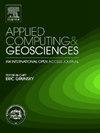Geological object recognition in legacy maps through data augmentation and transfer learning techniques
IF 3.2
Q2 COMPUTER SCIENCE, INTERDISCIPLINARY APPLICATIONS
引用次数: 0
Abstract
Maps are crucial tools in geosciences, providing detailed representations of the spatial distribution and relationships among geological features. Accurate recognition and classification of geological objects within these maps are essential for applications in resource exploration, environmental management, and geological hazard assessment. Along the years, many legacy geological maps have been accumulated, and many of them are not in data formats ready for machines to read and analyze. The inherent diversity and complexity of geological features, combined with the labor-intensive process of manual annotation, pose significant challenges in the usage of those maps. This study addresses these challenges by proposing an innovative approach that leverages legend data for data augmentation and employs transfer learning techniques to improve the quality of object recognition. Legend data from geological maps offer standardized symbols and annotations. Using them to augment existing datasets increases the diversity and volume of training data, thereby enhances the model's ability to generalize across various geological contexts. A deep learning model called EfficientNet is then fine-tuned using the augmented dataset to recognize and classify geological features more accurately. The model's performance is evaluated based on accuracy, recall, and F1-score, with results showing significant improvements, particularly for datasets with texture-rich information. The proposed method demonstrates that the combination of data augmentation and transfer learning significantly enhances the accuracy and efficiency of geological object recognition. This approach not only reduces the manual effort needed for geological object recognition but also contributes to the advancement of geological mapping and analysis.
利用数据增强和迁移学习技术在遗留地图中识别地质目标
地图是地球科学的重要工具,提供了地质特征之间空间分布和关系的详细表示。在这些地图中准确识别和分类地质目标对于资源勘探、环境管理和地质灾害评估的应用至关重要。多年来,已经积累了许多遗留的地质图,其中许多地图的数据格式不适合机器读取和分析。地质特征固有的多样性和复杂性,加上人工标注的劳动密集型过程,对这些地图的使用构成了重大挑战。本研究通过提出一种创新的方法来解决这些挑战,该方法利用图例数据进行数据增强,并采用迁移学习技术来提高对象识别的质量。地质图中的图例数据提供了标准化的符号和注释。使用它们来扩充现有的数据集,增加了训练数据的多样性和数量,从而增强了模型在各种地质背景下的泛化能力。然后,使用增强的数据集对名为“效率网”的深度学习模型进行微调,以更准确地识别和分类地质特征。该模型的性能基于准确性、召回率和f1分数进行评估,结果显示出显著的改进,特别是对于具有丰富纹理信息的数据集。结果表明,将数据增强与迁移学习相结合,可以显著提高地质目标识别的精度和效率。该方法不仅减少了人工识别地质目标的工作量,而且有助于推进地质填图和分析。
本文章由计算机程序翻译,如有差异,请以英文原文为准。
求助全文
约1分钟内获得全文
求助全文
来源期刊

Applied Computing and Geosciences
Computer Science-General Computer Science
CiteScore
5.50
自引率
0.00%
发文量
23
审稿时长
5 weeks
 求助内容:
求助内容: 应助结果提醒方式:
应助结果提醒方式:


